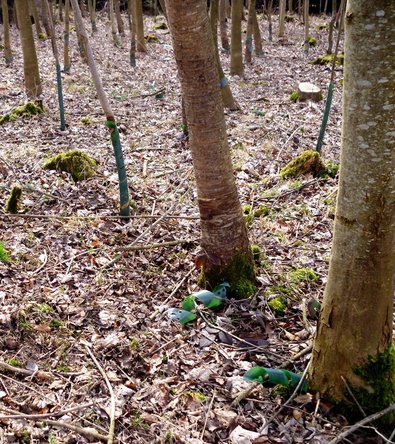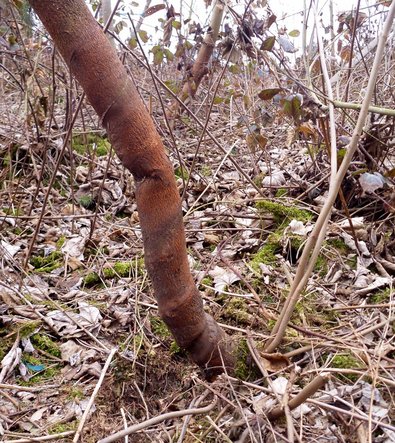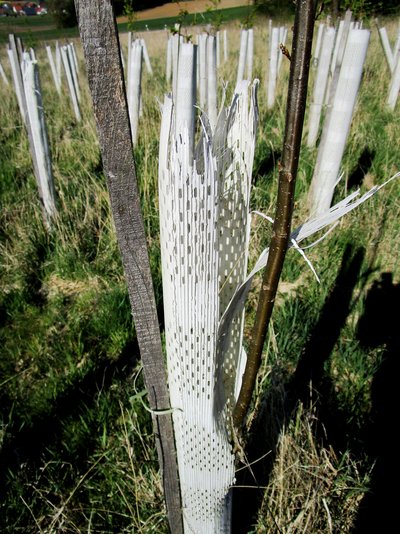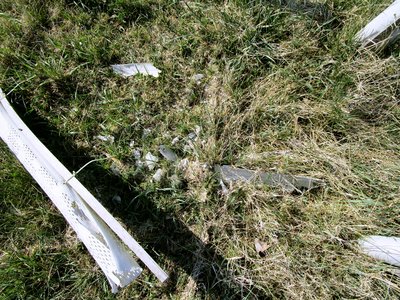Sustainable management and a healthy forest for the next generation - what forest owner does not pursue these goals? But in doing so people unfortunately often “only” consider the forest cover - and pay no attention to the legacy they are leaving in the soil. And yet the soil is extremely important for sustainability - and what happens in the soil cannot be reversed or changed at short notice. Soils have developed over millennia. All too carelessly, we take them for granted and assume they are unchanging.
That this is a misconception is shown for example by the consequences of litter use. The effects of this form of “management” of the forest floor, which was still being practised up to around 75 years ago, are felt to this day. There are constant changes in the soil as a result of our behaviour today, too. Like when we carelessly introduce foreign substances or objects into the forest and then fail or are unable to remove them again.
Forgotten metal holds many dangers
The use of iron to protect the forest from game, in the form of fences, wire tubes, deer rub protection spirals, metal thorn trees, or deer rub protection clips, has a long tradition – as, unfortunately, does the abandonment of these devices in the forest. Pure, ungalvanised iron rusts at some point, and is eventually absorbed by the forest soil as an element – or at least that is the theory. But usually, galvanised iron is used, as it lasts longer, and the durability of the waste it becomes is accordingly long.
Apart from the negative effect they have on the soil, metals left in the forest may cause injury to both animals and people. Machines and tools can also be damaged, for example when brush cutters or chainsaws come in contact with metal left lying around. Forgotten metal components that trees have simply grown over reduce the value of the timber - and can also cause damage to tools when the timber is processed.
Plastics - advertising claims are not always tenable
Plastics have increasingly taken hold in the forest in various forms since the early 1990s, primarily as a defence against game damage - from deer rub protection spirals to terminal shoot protector clips, and from tree tubes to protective netting. Still being falsely advertised in some cases, these aids at least appear to offer forest owners “all-round, worry-free solutions”. Accordingly, the product descriptions thus include claims such as “break down into water and carbon dioxide”; “thanks to additives, the plastics are biodegradable”; or “compostable and biodegradable according to DIN...”. This suggests that the products can remain in the forest - but this is not the case.
What is available are aids made of polypropylene (e.g. tree tubes and tree guard grates, deer rub protection spirals), polyvinyl chloride (e.g. deer rub protect spirals), polyethylene (e.g. terminal shoot protectors), biologically based plastics such as polylactate polymers (e.g. tree tubes), and ultimately also compounds made of natural materials, such as corn starch and plastics. What they all have in common is that they are made of plastic - or at least contain plastics in some form. And their decomposition both above and in the soil is not quite so straightforward.
But what actually happens when the plastics remain in the forest? Since the products are not usually labelled exactly, and the user never knows which product batch is made up of what, the degradation process remains a big unknown for the user. It starts with the fact that deer rub protection spirals either begin to disintegrate after a few years, or are so strong that they constrict the outward growth of the trees to the extent that the tree above them snaps off.
Plastic: should be removed from the forest before it fragments
Sunlight, water and warmth are generally the factors causing above-ground disintegration to set in. Far worse and less calculable however, are the knock-on effects that ensue in the soil: The components broken down above the ground enter the upper layers of the soil. There the processes of decomposition slow down due to the lack of ultra-violet radiation. Currently unexplained and incalculable reactions then begin with liquids in the soil, organic compounds in the humus, minerals, and other components of the soil. Metabolites and other products of decomposition are absorbed by organisms in the soil, and can influence, disturb or damage their vital functions.
These microorganisms are consumed in turn by larger organisms, and in this way, the microplastics enter the food chain. We are now aware of the dramatic effect of microplastics on the world’s oceans. Do we really want to cause such problems in the forest soil, too, just because the subject has not yet been so well researched?
Whether plastic or metal - the clear legal statement made in the German “Law on Life- Cycle Management” (“Kreislaufwirtschaftsgesetz”) applies: Materials that have served their purpose become waste, and must by law be removed and disposed of. None of the above-mentioned growth protectors or other protective measures is exempt from this requirement. So it does not matter what claims the manufacturers make with regard to compostability or biodegradability: as soon as the products have fulfilled their forestry purpose, they may no longer be left in the forest.
In the case of aids made of plastic, it is important to collect them before the plastics begin to fragment and disintegrate. When walking through forest stands, forest owners and personnel should thus take large sacks with them to collect all plastic items that are no longer needed. They can usually be disposed of at recycling and waste-disposal centres quite easily and without charge as “materially equivalent, non-packaging plastics”.
Microplastics also in additives
For several years now, soil additives have also been available to enhance the soil and its water retention capacity. These super-absorbers, which are given to the plant as granules or tablets upon or after planting, consist primarily of cross-linked polyacrylate polymers that can store and release water. A positive effect on forest crops is not generally to be expected. On the contrary, they are likely to contaminate the soils with microplastics.
Plan the removal when you plan the installation
Anyone choosing to rely on plastic products should as far as possible choose durable, multi-use products that can thus also be removed from the forest again. Ensure you keep records of all protective measures to help you with your planning when it comes to their disposal, and also for your successors. Record the year of installation on the product with an indelible marker pen. Calculate the costs of dismantling and disposing of the devices in advance and during maintenance work - you should calculate approx. €1.00 for the dismantling of each deer rub protector or tree tube.
The cheapest option is however to avoid the use of any protective products at all. Since it is usually a case of taking preventive measures to protect trees from browsing or deer-rub, it makes sense to contact whoever is responsible for hunting in the area. You should point out the problem areas and explain the need for protection, before outlining the necessary hunting priorities in order to reduce the need for protective measures as far as possible.




